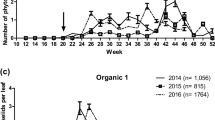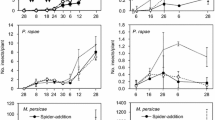Abstract
The effect of pulse intercrops on some borer pests of sugarcane and general predators was examined in two field studies. In a replicated experiment with black gram, cowpea, green gram and soybean as intecrops, the incidence of shoot borerChilo infuscatellus Snellen (Leptidoptera : Crambidae) did not differ significantly amongst the different combinations and control. The incidence of top borerScirpophaga excerptalis Wlk. (Lepidoptera : Pyralidae) was negligible in all combinations. Counts of predators, comprising spiders and coccinellids, showed marginal differences. In the second study at farmers’ fields, shoot borer incidence was significantly higher in 25 days and 65 days old sugarcane-soybean diculture plots than in sugarcane monocrop plots of corresponding age; the differences were not significant in a 30 days old crop. Mean predator numbers did not differ significantly between intercrop and monocrop in these three plots. The importance of factors such as crop combination, temporal and spatial patterns of planting, agronomic suitability, etc. in sugarcane-based ploycultures for sugarcane pest management is discussed.
Similar content being viewed by others
References
Altieri, M.A., Francis, C.A., Schoonhoven, A. van and Doll, J.D. (1978). A review of insect prevalence in maize (Zeamays L.) and bean (Phaseolus vulgaris L.) polycultural systems. Fld Crops Res.,1 (1): 33–49.
Baliddawa, C.W. (1985). Plant species diversity and crop pest control: an analytical review. Insect Sci. Applic.,6 (4) : 479–487.
David, B.V. (1987). Trends in production and use of pesticides in India. In: M. Veerabhadra Rao, S. Sithanantham (eds). Plant Protection in Field Crops, Natn. Semin. Pl. Prot. Fld Crops. Central Plant Protection Training Institute, Hyderabad, India, pp. 1–14.
David, H. and Sithanantham, S. (1986). Integrated pest management. In:H. David, S. Easwaramoorthy, R. Jayanthi (eds). Sugarcane Entomology in India. Sugarcane Breeding Institute, Coimbatore, India, pp. 459–473.
Easwaramoorthy, S., David, H., Kurup, N.K. and Santhalakshmi, G. (1994). Studies on the spider fauna of sugarcane ecosystem in southern peninsular India. J. Biol. Control,8 (2): 85–93.
Easwaramoorthy, S., Srikanth, J., Santhalakshmi, C. and Kurup, N.K. (1996). Life history and prey acceptance of commonly occurring spiders in sugarcane ecosystem. J. Biol. Control,10: 39–47.
Easwaramoorthy, S., Srikanth, J. and Kurup, N.K. (1997). Ground beetles in sugarcane ecosystem: new records and seasonal fluctuations. J. Soil Biol. Ecol.,17 (1) : 73–75.
Garcia, J., Cardona, C. and Raigosa, J. (1979). Evaluation of populations of insect pests in mixed sugar-cane and beans and their relation to yield. Revta Colombiana de Entomologia,5 (1/2): 17–24.
Kailasam, C. (1994). Evaluation of nitrogen levels and seed rates for short duration sugarcane (Co 8338) intercropped with three soybean cultivars of varying growth habits. Ph.D. Thesis, Tamil Nadu Agricultural University, Coimbatore, India.
Kalra, A.N., Varma, Ashok and Srivastava, A.N. (1975). Companion cropping of sugarcane and wheat: pest problem and how to tackle it. Sug. News,7 (7) : 11–12.
Leroi, B., Alzouma, I. and Huignard, J. (1990). The influence of intercropping millet (Pennisetum typhoides Burm) with cowpea (Vigna unguiculata Walp) on the egg-laying and de velopment ofBruchidius atrolineatus (Pic) (Coleoptera: Bruchidae). Agric. Ecosystems Environ.,31 (1) : 39–48.
Mahadevan, N.R. and Chelliah, S. (1985). Influence of intercropping legumes with sorghums on the stem borer, Chilo partellus (Swinhoe). In: A. Regupathy, S. Jayaraj (eds). Behavioural and Physiological Approaches in Pest Management. Tamil Nadu Agricultural University, CoimbatoreIndia, pp. 188–190.
Misra, S.C. and Hora, B.S. (1982). Note on the incidence of top-borer (Tryporyza nivella Fabr.) and pink-borer (Sesamia inference Wlk.) on sugarcane grown in companion cropping pattern. Indian J. agric. Sci.,52 (1): 45–46.
Parihar, S.B.S and Singh, O.P. (1992). Effect of cropping patterns on build up ofAgrotis ipsilon andHelicoverpa armigera (Hub.) in potato. Natn. Acad. Sci. Lett.,15 (2): 57–58.
Rajendran, B., Haneefa, A.M., Umapathy, G. and Venkatakrishnan, J. (1998). Cultural measures to curb shoot borer menace in sugarcane. Insect Environ., 4 (2):48–49.
Ramesh, P., Kailasam, C. and Srinivasan, T.R. (1994). Performance of sugarcane(Saccharum officinarun L.) under surface drip, sub surface drip (biwall) and furrow methods of irrigation. J. Agron. Crop Sci.,172: 237–241.
Risch, S.J. (1983). Intercropping as cultural pest control: prospects and limitations. Environ. Mgmt,7 (1) : 9–14.
Risch, S.J., Wrubel, R. and Andow, D. (1982). Foraging by a predaceous beetle,Coleomegilla maculata (Coleoptera: Coccinellidae) in a polyculture : effects of plant density and diversity. Environ. Ent.,11 (4) : 949–950.
Showier, A.T., Reagan, T.E. and Knaus, R.M. (1990). Sugarcane-weed community interactions with arthropods and pathogens. Insect Sci. Applic.,11 (1): 1–11.
Singla, M.L., Duhra, M.S., Dhaliwal, Z.S. and Sandhu, S.S. (1994). Effect of inter cropping in autumn planted sugarcane on the incidence ofScirpophaga excerptalis Wlk. and termites. J. Insect Sci.,7 (2): 199–201.
Srikanth, J., Easwaramoorthy, S., Kurup, N.K. and Santhalakshmi, G. (1997). Spider abundance in sugarcane: impact of cultural practices, irrigation and post-harvest trash burning. Biol. Agric. Hort.,14 : 343–356.
Tewari, R.K. and Om Prakash (1980). Effect of intercrops on sugarcane top borer. Farmer and Parliament,15 (7): 35–36.
Varun, C.L., Singh, S., Pandey, K.P. and Singh, S.B. (1994). Influence of companion cropping of spices on the incidence of early shoot borer (Chilo infuscatellus Snell.) in sugarcane. Indian Sug.,44 (1): 21–22.
Verma, R.S., Motiwale, M.P., Chauhan, R.S. and Tewari, R.K. (1981). Studies on intercropping of spices and tobacco with autumn sugarcane. Indian Sug.,31 (7): 451–456.
Verma, R.S., Kumar, R. and Yadav, R.L. (1984). Status of research in inter-cropping with sugarcane. Indian Sug. Crops J.,10 (2): 1–6.
Wankhede, N.P. and Parashar, K.S. (1975). Studies on intercropping of cotton (Gossypium hirsutum L.) in spring planted sugarcane (Saccharum officinarum L.). Indian Sug.,24 (11): 951–954.
Author information
Authors and Affiliations
Corresponding author
Rights and permissions
About this article
Cite this article
Srikanth, J., Easwaramoorthy, S. & Kurup, N.K. Borer and predator incidence in sugarcane intercropped with pulses. Sugar Tech 2, 36–39 (2000). https://doi.org/10.1007/BF02945742
Published:
Issue Date:
DOI: https://doi.org/10.1007/BF02945742




